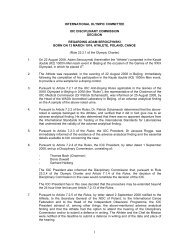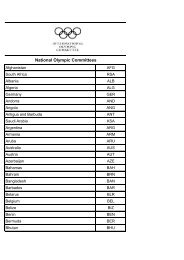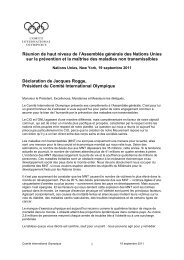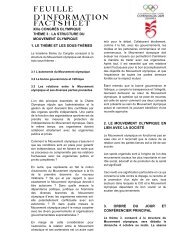THE OLYMPIC GAMES? - International Olympic Committee
THE OLYMPIC GAMES? - International Olympic Committee
THE OLYMPIC GAMES? - International Olympic Committee
You also want an ePaper? Increase the reach of your titles
YUMPU automatically turns print PDFs into web optimized ePapers that Google loves.
WHY ARE <strong>THE</strong>RE OPENING AND CLOSING<br />
CEREMONIES AT <strong>THE</strong> <strong>OLYMPIC</strong> <strong>GAMES</strong>?<br />
The beginning and end of the <strong>Olympic</strong><br />
Games are marked by ceremonies.<br />
These events provide an unparalleled<br />
illustration of the <strong>Olympic</strong> values, and<br />
are one of the elements that make the<br />
<strong>Olympic</strong> Games stand apart from other<br />
sports events. As both a celebration of<br />
sport and culture and a showcase for universality and<br />
peace, the ceremonies make up a ritual that symbolises<br />
the unity of body and mind.<br />
Today the opening ceremonies begin with the official<br />
component.<br />
Pride of place is given to the protagonists of the Games,<br />
the athletes! They line up behind their country’s flag<br />
and parade in front of the spectators. As a tribute to<br />
the origins of the <strong>Olympic</strong> Games, Greece traditionally<br />
leads the parade. The host country delegation is the<br />
last to enter the stadium.<br />
After the head of state of the host country has<br />
declared the Games open, the <strong>Olympic</strong> anthem is<br />
played and the <strong>Olympic</strong> flag is brought in. The flag,<br />
which is often carried by athletes, is then hoisted in<br />
the stadium.<br />
The arrival of the flame and the lighting of the cauldron<br />
are the highlights of the opening ceremony. A symbolic<br />
release of doves represents the hope for peace during<br />
the Games.<br />
Since the Games of the Olympiad in Antwerp in 1920,<br />
an athlete has sworn the <strong>Olympic</strong> oath on behalf of<br />
all the participants. Since 1972, a judge has also done<br />
the same for the officials. The text of the oath was<br />
modified starting with the 2000 <strong>Olympic</strong> Games in<br />
Sydney to include a reference to competing without<br />
resorting to drugs.<br />
The official ceremony is followed by an artistic<br />
programme featuring colourful costumes, dancing,<br />
singing and music. Sometimes the creativity and<br />
imagination of the artistic directors glows in the light<br />
of a magnificent fireworks display.<br />
Whether seated in the stadium or in their favourite<br />
armchair in front of the television, spectators around<br />
the world join in the party atmosphere!<br />
The end of the <strong>Olympic</strong> Games is marked by the closing<br />
ceremony on the last day of competition. Ever since<br />
the 1956 Games in Melbourne, the athletes parade<br />
together, rather than by delegation. The <strong>Olympic</strong> flag<br />
is handed over to the mayor of the host city of the next<br />
<strong>Olympic</strong> Games. Although the flame is extinguished, a<br />
promise is thus made to meet again in four years’ time.<br />
14 15

















